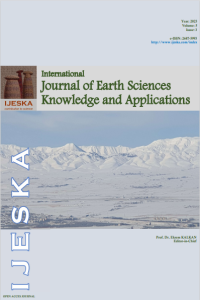Abstract
References
- Abes, A., Irofti, D., Ifrene, G.E.H., Rasouli, V., Djemai, S., 2021. The Impact of Geometric Attributes of Fractures on Fluid Flow Characteristics of Reservoir: A Case Study in Alrar Field, Algeria. in 55th US Rock Mechanics/Geomechanics Symposium, OnePetro.
- Beecher, C.D., 1928. “Increasing the Recovery of Oil by Repressuring” Petroleum Development and Technology in 1927, AIME, New York City 77, 379-382.
- Geffen, T.M., 1983a. Oil production to Expect from Known Technology. Oil & Gas Journal 66.
- Geffen, T.M., 1983b. Improved Oil Recovery Could Help Ease Energy Shortage. World Oil 84.
- Muskat, M.M., 1949a. Physical Principles of Oil Production, McGraw-Hill, New York City, 709-810.
- Muskat, M.M., 1949b. Physical Principles of Oil Production, McGraw-Hill, New York City, 715-724.
- Willhite, G.P., 1986. Waterflooding, SPE, Richardson, Texas 1.
- Haynes, H.J., 1976. Enhanced Oil Recovery, NPC, Industry Advisory Council to the US Dept. Of the Interior, Washington, DC.
- Taber, J.J., Martin, F.D., R., Seright, S., 1997a. EOR Screening Criteria Revisited— Part 1: Introduction to Screening Criteria and Enhanced Recovery Field Projects. SPE Res Eng 12, 189-198. https://doi.org/10.2118/35385-PA.
- Taber, J. J., Martin, F. D., and R. S. Seright. 1997b. "EOR Screening Criteria Revisited—Part 2: Applications and Impact of Oil Prices." SPE Res
Abstract
Enhanced oil recovery (EOR) methods are crucial for extracting additional oil from reservoirs after primary and secondary recovery stages. This paper focuses on the screening criteria employed in the decision-making process for selecting appropriate EOR methods. The screening criteria are classified into three main categories: conventional screening, geologic screening, and advanced screening. Conventional screening involves comparing average reservoir properties with predefined validity limits to determine the suitability of a recovery process. Geologic screening takes into account detailed information on reservoir geology, such as heterogeneity and connectivity, to assess the controls on EOR processes. Advanced screening utilizes data mining, artificial intelligence techniques, and multidimensional maps to consider multiple reservoir and fluid properties simultaneously. The paper also provides a comprehensive classification of EOR methods, including gas methods, waterflooding methods, and thermal methods. Various screening criteria techniques are discussed, which are based on reservoir parameters and physics of each EOR process. The importance of decision enablers, such as influence diagrams, in framing the decision-making process is highlighted. The paper concludes by emphasizing the need for rational decision making, the role of decision makers in committing resources, and the selection of quantifiable objective functions for effective EOR method selection. Given the rising oil prices and concerns about future supplies, the application of screening criteria to identify suitable EOR methods becomes crucial for maximizing oil recovery and addressing the challenges faced by oil companies and authorities.
Keywords
Enhanced oil recovery Screening criteria Conventional screening Geologic screening Advanced screening
References
- Abes, A., Irofti, D., Ifrene, G.E.H., Rasouli, V., Djemai, S., 2021. The Impact of Geometric Attributes of Fractures on Fluid Flow Characteristics of Reservoir: A Case Study in Alrar Field, Algeria. in 55th US Rock Mechanics/Geomechanics Symposium, OnePetro.
- Beecher, C.D., 1928. “Increasing the Recovery of Oil by Repressuring” Petroleum Development and Technology in 1927, AIME, New York City 77, 379-382.
- Geffen, T.M., 1983a. Oil production to Expect from Known Technology. Oil & Gas Journal 66.
- Geffen, T.M., 1983b. Improved Oil Recovery Could Help Ease Energy Shortage. World Oil 84.
- Muskat, M.M., 1949a. Physical Principles of Oil Production, McGraw-Hill, New York City, 709-810.
- Muskat, M.M., 1949b. Physical Principles of Oil Production, McGraw-Hill, New York City, 715-724.
- Willhite, G.P., 1986. Waterflooding, SPE, Richardson, Texas 1.
- Haynes, H.J., 1976. Enhanced Oil Recovery, NPC, Industry Advisory Council to the US Dept. Of the Interior, Washington, DC.
- Taber, J.J., Martin, F.D., R., Seright, S., 1997a. EOR Screening Criteria Revisited— Part 1: Introduction to Screening Criteria and Enhanced Recovery Field Projects. SPE Res Eng 12, 189-198. https://doi.org/10.2118/35385-PA.
- Taber, J. J., Martin, F. D., and R. S. Seright. 1997b. "EOR Screening Criteria Revisited—Part 2: Applications and Impact of Oil Prices." SPE Res
Details
| Primary Language | English |
|---|---|
| Subjects | Marine Geology and Geophysics |
| Journal Section | Review |
| Authors | |
| Publication Date | December 31, 2024 |
| Published in Issue | Year 2023 Volume: 5 Issue: 3 |


